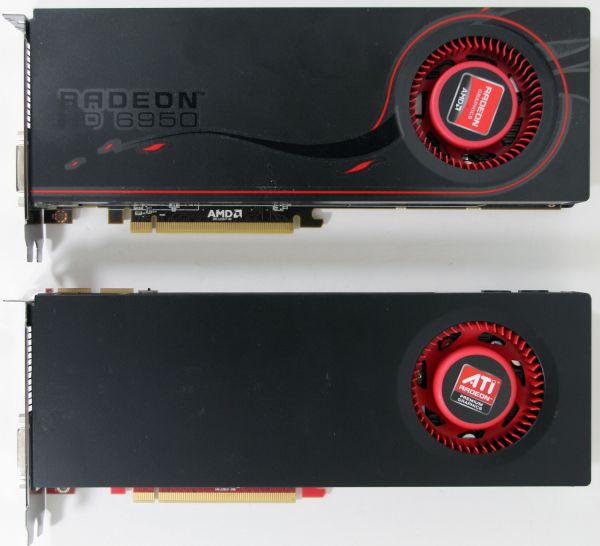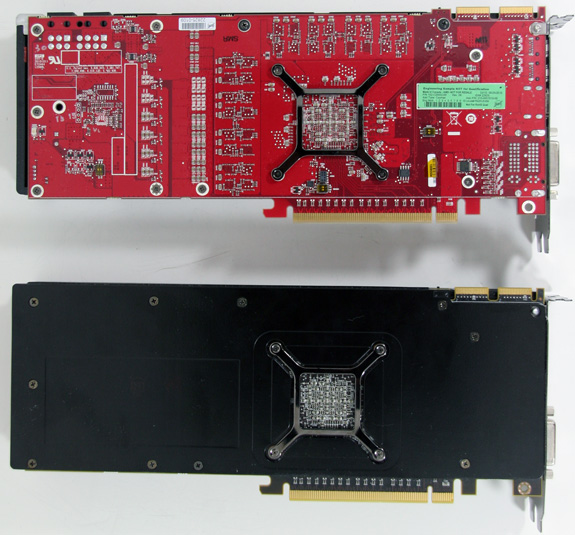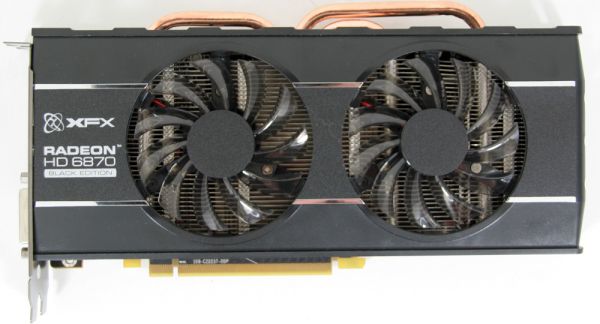AMD’s GTX 560 Ti Counter-Offensive: Radeon HD 6950 1GB & XFX’s Radeon HD 6870 Black Edition
by Ryan Smith on January 25, 2011 12:20 PM ESTMeet The Radeon HD 6950 1GB and XFX Radeon HD 6870 Black Edition
We’ll start our look at today’s cards with the headliner: AMD’s Radeon HD 6950 1GB. As we’ve previously established our 6950 is an engineering sample – perhaps an early one – so there’s not much to look at. Save for the kind of cosmetic defects you’d expect on an engineering sample, it’s for all practical purposes identical to the production 6950 2GB, and that’s intentional. AMD set out to make the 6950 1GB identical to the 6950 2GB other than the use of lower capacity GDDR5 chips, and this is what they have accomplished.

Top: 6950 2GB. Bottom: 6950 1GB Engineering Sample

Top: 6950 1GB Engineering Sample. Bottom: 6950 2GB
Since producing a 1GB card involves little more than replacing 2Gb memory chips with 1Gb memory chips, the true design innovations are going to come from AMD’s partners. Sapphire already has a 6950 1GB out with a custom cooler, and as AMD’s other partners get situated with 1GB cards we expect to see much of the same with them.
One item worth noting is that because our card is based on the reference design, it includes the BIOS switch at the top of the card. This means reference-based 1GB cards are going to have the same BIOS failsafe in them – however suitable BIOSes for the unlockers among you are another matter. Without some BIOS hacking (and possibly more), existing 6970 BIOSes are unsuitable as they’re meant for 2GB cards. Until such a time comes where a 6970 1GB BIOS can be developed, the 6950 1GB is not going to be a good card for unlocking. For the time being unlockers are going to want to stick to 2GB cards.
The Radeon HD 6950 1GB is launching with an MSRP of $259. At this time you can find reference-style 2GB cards for as little as $269, making the 1GB cards a rather simple $10 trade-off if you don’t mind mail-in rebates.
XFX Radeon HD 6870 Black Edition
Our second card of the day is XFX’s 2nd generation Radeon HD 6870 Black Edition (687A-ZDBC), the card that AMD originally proposed as the GTX 560 Ti’s competitor. Clocked at 940MHz core and 1150MHz (4.6Gbps data rate) memory, it runs at 40Mhz (4%) core and a 100MHz (9%) memory over the reference 6870. Overall this is a mild overclock, particularly as the 6870 is core-bound as opposed to memory-bound most of the time.
With such a mild overclock we had little reason to pay attention to the card, particularly once we completed our GTX 560 Ti benchmarking and saw that it was 10-20% faster than the stock-clocked 6870. Indeed it wasn’t until we tested the card that we saw something that grabbed our attention. Or perhaps I should say heard.
At the risk of spoiling the rest of our article, this card is for all practical purposes silent. At idle it’s only as loud as the noise floor of our GPU testbed, and at load – even under Furmark – it’s the same story. We measured 41.4dB at both idle and load, making it the quietest actively cooled mid-range card we have ever tested in our existing rig. Even the remarkably quiet GTX 460 can’t hold its ground to the 6870 Black Edition, it’s that quiet.
So what’s XFX’s secret? It’s much the same story as with the GTX 460. While the 6870 reference design uses a blower XFX is using an open-air cooler, specifically a double-fan cooler with 3 copper heatpipes that’s very similar to MSI’s Twin Frozor and Gigabyte’s Super Overclock cooler. Open-air coolers are already capable of being much quieter than blowers, and when done correctly a double-fan arrangement can be quieter than driving a single fan at higher speeds. Combining this highly effective cooler with the 6870’s Black Edition’s low TDP (~160W) results in a very quiet card that by all indications cannot be beaten at this point in time.
Rounding out the package, there are no real meaningful extras to discuss. Aside from some trinkets (stickers, case badges, etc), the only other piece of hardware in the box is a short CrossFire bridge. XFX has kept it simple: the only things that really matter are the card and XFX’s lifetime warranty.
The Radeon HD 6870 Black Edition doesn’t have a set MSRP, but it’s currently available for around $229 with a mail-in rebate, making it roughly $10 more expensive than a stock-clocked card. Or compared to XFX’s lineup, the non-Black Edition version of this card is a mere $4 less at $225; so you’re looking at a $4 factory overclock and $6 for a supurb custom cooler.












111 Comments
View All Comments
rdriskill - Tuesday, January 25, 2011 - link
Given that it is a lot easier to find a 1920 x 1080 monitor now than it is to find a 1920 x 1200 monitor, would that resolution make more sense to list in these kinds of comparisions? I realise it wouldn't make much of a difference, but it is kind of strange to not see what, at least in my area, is the most common native resolution.james.jwb - Tuesday, January 25, 2011 - link
wouldn't mind seeing 27" res include at the high end (2560x1440) as up there pushes the cards much harder and could make all the difference between playable and unplayable. I realize this is more work though :)Ryan Smith - Tuesday, January 25, 2011 - link
As 16:9 monitors have 90% of the resolution of 16:10 monitors, the performance is very similar. We may very well have to switch from 19x12 to 19x10 because 19x12 monitors are becoming so rare, but there's not a lot of benefit in running both resolutions.The same goes for 25x14 vs. 25x16. Though in that case, 25x16 monitors aren't going anywhere.
Makaveli - Tuesday, January 25, 2011 - link
Great review.As for the complaints GTFO, is it somehow affecting your manhood that there is an overclocked card in the review?
Some of you really need to get a life!
ctbaars - Tuesday, January 25, 2011 - link
Hey! Don't you talk to Becky that way ....silverblue - Tuesday, January 25, 2011 - link
It's overclocked, sure, but it's an official AMD product line. If AMD had named it the 6880, I don't think anyone would've questioned it really.Shadowmaster625 - Tuesday, January 25, 2011 - link
The 6870 has 56 texture units and the 6950 has 88 , or 57% more. Yet if you add up all the scores of each you find that the 6950 is only 8% faster on average. This implies a wasted 45% increase in SPs and/or texture units (which one?), as well as about 800 million wasted transistors. Clearly AMD needed to add more ROPs to the 6950. Also, since the memory clock is faster on the 6950, this implies even more wasted transistors. If both cards had the same exact memory bandwidth, they might very well only be 4% apart in performance! AMD's gpu clearly responds much more favorably to an increase in memory bandwidth than it does to increased texture units. It really looks like they're going off the wheels and into the weeds. What they need is to increase memory bandwidth to 216G/s, and increase their ROP-to-SIMD ratio to around 2:1.Yes I know about VLIW4... but where is the performance? Improvements should be seen by now. Like what Nvidia did with Civ 5. I'm not seeing anything like that from AMD and we should have been seeing that by now, in spades.
B3an - Wednesday, January 26, 2011 - link
....I like how you've completely missed out the fact that the 6870 is clocked 100MHz higher on the core, and the 6870 Black is 140MHz higher. You list all these other factors, and memory speeds, but dont even mention or realise that the 6870/Black have considerably higher core clocks than the 6950.Shadowmaster625 - Wednesday, January 26, 2011 - link
It is probably clocked higher because it has almost a billion fewer transistors. Which begs the question.... what the hell are all those extra transistors there for if they do not improve performance?DarkHeretic - Tuesday, January 25, 2011 - link
This is my first post, i've been reading Anand for at least a year, and this concerned me enough to actually create a user and post."For NVIDIA cards all tests were done with default driver settings unless otherwise noted. As for AMD cards, we are disabling their new AMD Optimized tessellation setting in favor of using application settings (note that this doesn’t actually have a performance impact at this time), everything else is default unless otherwise noted."
While i read your concerns about where to draw the line on driver optimisation Ryan, i disagree with your choice to disable select features from one set of drivers to the next. How many PC users play around with these settings apart from the enthusiasts among us striving for extra performance or quality?
Surely it would make be far fairer for testing to leave drivers at default settings when benchmarking hardware and / or new sets of drivers? Essentially driver profiles have been tweaking performance for a while now from both AMD and Nvidia, so where to draw the line on altering the testing methodology in "tweaking drivers" to suit?
I'll admit, regardless of whether disabling a feature makes a difference to the results or not, it actually made me stop reading the rest of the review as from my own stance the results have been skewed. No two sets of drivers from AMD or Nvidia will ever be equal (i hope), however deliberately disabling features meant for the benefit of the end users, just seems completely the wrong direction to take.
As you are concerned about where AMD is taking their driver features in this instance, equally i find myself concerned about where you are taking your testing methodology.
I hope you can understand my concerns on this and leave drivers as intended in the future to allow a more neutral review.
Regards